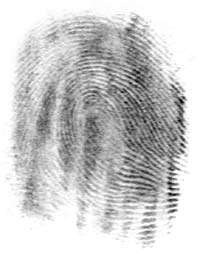April 4, 2009 weblog
Why Do We Have Fingerprints?
Lisa Zyga
contributing writer

(PhysOrg.com) -- Unlike most wrinkles on our bodies, which appear due to bending and stretching of the skin, fingerprints aren't the result of repeated motion. Each of us is born with a unique set of them, although scientists aren't exactly sure what purpose fingerprints serve.
One possible purpose of fingerprints is that they improve our sense of touch. In a recent study, scientists have investigated this idea by performing a series of experiments with artificial fingertips made of rubber-like sensors. The scientists compared the sensitivity between these grooved artificial fingertips and a smooth skin-like material, and found that the grooved fingertips produced vibrations up to 100 times stronger than the smooth material when sliding against a slightly rough surface.
The researchers, from the Ecole Normale Superieure in Paris, explained that increased vibrations give us an enhanced sense of touch, especially for detecting textures. As you rub your fingers across a textured surface, your fingerprints specifically amplify vibrations in an optimized frequency range to stimulate the Pacinian corpuscles, which are nerve endings in the skin that detect textures. In turn, texture information allows us to identify objects by touch.
As the finding demonstrates, not only does our nervous system (the "software") play a role in tactile computation, but the physical characteristics of the body (the "hardware") also enhance the computation when sensing.
However, the research doesn't explain why everyone's fingerprints are unique, or why our fingerprints are typically arranged in elliptical swirls. The scientists suggest that the loop design may ensure that some ridges are always brushing perpendicular to a surface, no matter the orientation of the fingertips. In addition, the researchers predict that this work could lead to enhanced tactile feedback for prosthetic hands.
More information: "The Role of Fingerprints in the Coding of Tactile Information Probed with a Biomimetic Sensor." J. Scheibert, S. Leurent, A. Prevost, and G. Debregeas (13 March 2009) Science 323 (5920), 1503. DOI: 10.1126/science.1166467
via: CERN Courier and Science
© 2009 PhysOrg.com
Written for you by our author Lisa Zyga—this article is the result of careful human work. We rely on readers like you to keep independent science journalism alive. If this reporting matters to you, please consider a donation (especially monthly). You'll get an ad-free account as a thank-you.




















